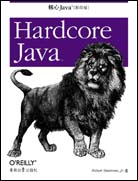
核心Java(影印版)
出版时间:2005年10月
页数:356
Java已经迅速成为时下最重要的编程语言之一,尤其对于专业及企业级项目而言。从其诞生之初主要用于编写Web applet,到后来用于servlet、EJB和数据库访问而不断成熟,Java已经成为目前软件开发者手中一种复杂而健壮的工具。
《核心Java》将Java涉及的庞大内容合理地划分,逐部分地揭示其中隐藏的要点和技巧,这些要点和技巧能使你从一个刚入门的编程者成长为一个经验丰富的专业开发人员。本书将带你快速把握Java的基础,然后进一步学习高级内存管理技术,优化及在字节码层次上提升效率的技术,以及快速创建GUI所需的技术。此外,在领会Java语言错综复杂的关系的同时,你将掌握编写和维护牢固的、没有错误的代码的艺术。
《核心Java》包含的内容有:
*使用final关键字来优化和保护你的Java类
*所有类型嵌套类(nested class),包括如何优化匿名类(anonymous class)和内部类(inner class)
*不可变对象(immutable object),包括何时使用(或不应该使用)它们的独特技巧
*如何通过异常处理管理来消除bug
*常量及其对Java内存模型的影响
*Java反射(reflection),我们的讨论远远超越其他书中“Hello World”示例的范畴
*在标准版本和企业级版本下如何构建和使用动态代理
*weak reference,包括其使用模式和在垃圾收集及内存管理机制中的角色
《核心Java》对每一个程序员而言都是无价之宝,即便是最老道的开发者也会发现阅读此书他们会大有收获,对Java的理解将被提升,直至能够真正地高水平地应用Java语言。书中共有超过千行注释详细的可执行代码来帮助阐释各个概念。
《核心Java》将Java涉及的庞大内容合理地划分,逐部分地揭示其中隐藏的要点和技巧,这些要点和技巧能使你从一个刚入门的编程者成长为一个经验丰富的专业开发人员。本书将带你快速把握Java的基础,然后进一步学习高级内存管理技术,优化及在字节码层次上提升效率的技术,以及快速创建GUI所需的技术。此外,在领会Java语言错综复杂的关系的同时,你将掌握编写和维护牢固的、没有错误的代码的艺术。
《核心Java》包含的内容有:
*使用final关键字来优化和保护你的Java类
*所有类型嵌套类(nested class),包括如何优化匿名类(anonymous class)和内部类(inner class)
*不可变对象(immutable object),包括何时使用(或不应该使用)它们的独特技巧
*如何通过异常处理管理来消除bug
*常量及其对Java内存模型的影响
*Java反射(reflection),我们的讨论远远超越其他书中“Hello World”示例的范畴
*在标准版本和企业级版本下如何构建和使用动态代理
*weak reference,包括其使用模式和在垃圾收集及内存管理机制中的角色
《核心Java》对每一个程序员而言都是无价之宝,即便是最老道的开发者也会发现阅读此书他们会大有收获,对Java的理解将被提升,直至能够真正地高水平地应用Java语言。书中共有超过千行注释详细的可执行代码来帮助阐释各个概念。
- Preface
- 1. Java in Review
- Core Concepts
- Syntax Issues
- Access Issues
- Common Mistakes
- 2. The Final
- Final Constants
- Final Variables
- Final Parameters
- Final Collections
- Instance-Scoped Variables
- Final Classes
- Final Methods
- Conditional Compilation
- Using final as a Coding Standard
- 3. Immutable Types
- Fundamentals
- Immutable Problems
- Immutable or Not
- 4. Collections
- Collection Concepts
- Implementations
- Choosing a Collection Type
- Iterating Collections
- Collection Gotchas
- 5. Exceptional Code
- Two Types of Exceptions
- When to Use Exceptions
- Finally for Closure
- Exceptional Traps
- 6. Nested Classes
- Inner Classes
- Limited-Scope Inner Classes
- Static Nested Classes
- Double Nested Classes
- Nested Classes in Interfaces?
- Nested Interfaces
- Nested Class Rules
- 7. All About Constants
- Substitution Constants
- Bit Fields
- Option Constants
- Constant Objects
- Constant Encapsulation
- 8. Data Modeling
- The Requirements Document
- Natural Language Modeling
- Aspects of Well-Designed Data Models
- Reusable Data Constraints
- Persistence
- 9. Practical Reflection
- The Basics
- Reflection and Greater Reflection
- Applying Reflection to MutableObject
- Performance of Reflection
- Reflection + JUnit = Stable Code
- 10. Proxies
- What Is a Proxy?
- Two Kinds of Proxies
- Proxy Gotchas
- 11. References in Four Flavors
- The Problem
- Java Reference Concepts
- The Java Reference Classes
- Practical Applications
- A Weak Listener
- When to Use References
- 12. Tiger: JDK 1.5
- New Language Features
- Generics
- Other Improvements in Tiger
- Index
书名:核心Java(影印版)
作者:Robert Simmons Jr. 著
国内出版社:东南大学出版社
出版时间:2005年10月
页数:356
书号:7-5641-0040-0
原版书出版商:O'Reilly Media
The animal on the cover of Hardcore Java is a lion. The lion (Panthera leo) is the largest of the African carnivores. Males, distinguished by their tawny manes, can weigh up to 500 pounds; the smaller, maneless females can weigh up to 300 pounds. Both sexes are powerfully built. Their muscular bodies can take down such large prey as buffalo, giraffe, and young elephants, but they usually hunt medium-to large-sized herd animals,such as antelopes and gazelles.
The regal designation 襨ing of the jungle
The regal designation 襨ing of the jungle
购买选项